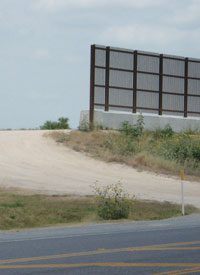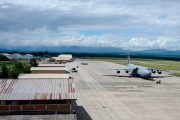
To some Texas folks, a border fence seemed like a good idea before it was built. As a solution toward preventing millions of illegal immigrants, Mexican and otherwise, from entering the United States, it appeared a simple answer, relieving pressure on overburdened American hospitals, prisons, and schools. It promised the added bonus of stopping the unstaunchable flow of illegal drugs and corresponding crime and violence from Mexico. The reality fell far from the speculation.
Most folks, quite reasonably, assume the fence is actually on the border. In some parts of Arizona, California, or New Mexico, where the border is “dirt to dirt,” that is true, but not in Texas. The fence does not follow the border, but was placed largely on a levee built to prevent flooding from the Rio Grande. The meandering river, area topography, the levee system, and political considerations combined to result in fence placement that is, in some places, as much as two miles from the border. As a national security tool it’s a bad joke — full of gaps and in some places non-existent. But it’s no joke to the Texans affected by it — namely those whose homes and businesses are trapped in a no-man’s land between the fence and the river/border. The people could leave, but their homes and businesses can’t. Where would they go?
To understand the effect of the fence, one needs to understand Texas border life.
Robert Lucio, owner/operator of the 165-acre Fort Brown Memorial Golf Course, is a living example of the people who built lives crossing back and forth between Texas and Mexico. Physically and culturally, the lines between the two blur at the border, primarily because for generations border families — Mexican and American — have managed to peacefully live and work, crafting a culture that is uniquely “border.” Lucio’s family has lived in the region for 200 years — longer than Texas has been a state, or even its own country. He grew up here and, perhaps more than many, considers himself part of the land. His father was a Cameron County deputy sheriff and raised a large family, instilling honor and pride in his children. But Lucio’s sense of place has been grossly disrupted, even destroyed, by “The Fence.” And the financial damage done to his livelihood is not theoretical.
“The golf course [built in 1950] and the river provided recreation and a sense of community for Brownsville,” Lucio notes. “That’s especially important here because we’re on the border, and we don’t have the things other places do. We’re forgotten here.”
“My brother, now a Texas State Senator, started out as a caddy on this course. The golf course later closed, and I took it over in 1987, reopening with an initial $5,000 loan and a business degree — I was so grateful to have this opportunity. My son grew up on this course with the workers and the machines. As a small businessman, I do everything! I run the clubhouse, and I’m the greenskeeper, the golf pro, and the janitor. I know every tree, and every slope on every green. I know this place. But now my credit is ruined, and this has caused a lot of emotional distress for us.”
What happened? Lucio leases the land and the business from the University of Texas at Brownsville (UTB). In 2005, he rebuilt the golf course and clubhouse with an SBA loan. One year later, in September 2006, Congress announced and passed the Secure Fence Act, signed into law by President Bush.
The goal of the act, ostensibly, was to secure the border by decreasing illegal entry, drug trafficking, and security threats. Supporters believed it would force those seeking entry to do so legally by making the physical obstacles too difficult to overcome illegally. And that it would curb the illegal drug trade. It did anything but.
It was successful, however, at curbing traffic to Lucio’s business. The Fort Brown Memorial Golf Course lies entirely behind the fence, meaning it is between the fence and the river. Lucio told TNA that when the fence was built, its placement was determined, not by the actual border, but the course of the levee; the government already owned the levee, so it became the natural place to build the fence without having to go through the process of eminent domain with landowners and paying “just compensation” for property, as our Constitution requires.
Our federal government spends billions of dollars each year in foreign aid for infrastructure development (roads, bridges, dams, levees, power plants and grids, etc.) in Iraq, Afghanistan, Pakistan, and scores of other countries, but couldn’t come up with the millions necessary to purchase the land to build the fence on the actual U.S.-Mexican border.
During the meetings and discussions about fence construction, Lucio was never invited to sit in, even though his business was clearly a stakeholder. He would have liked to have been able to inform his members what was going on, but wasn’t given any information. The Department of Homeland Security (DHS) website states that stakeholder input was a major factor in fence location, but that didn’t happen.
When the fence was finally built, small concessions were made to the walled-out course owner, such as giving the fence by the course a slightly less intimidating appearance. The portion separating the golf course and campus is the only section that is not 18 feet high, but 12 feet, and Lucio says it’s called a “friendly fence.” It isn’t constructed of the more substantive iron posts, but smaller pillars painted white, connected by green fencing, and spaced much further apart. Nevertheless, once it went up, Lucio lost 60 percent of his members because of their perceptions of what it meant. By the time six months passed, he experienced a 15-percent revenue loss — his profit margin. No compensation was forthcoming from the government for the loss of value to the business.
In 2007, Lucio contacted the office of Texas U.S. Senator John Cornyn to tell him about his predicament. Cornyn didn’t respond to or even acknowledge Lucio’s comments. “That’s my Senator,” he lamented.
Then Brownsville was visited by Michael Chertoff, then-United States Secretary of Homeland Security, but Lucio reports that the Secretary came only to talk to the sector’s Border Patrol, not landowners. Over a local radio station, Lucio issued a lunch invitation to Chertoff, but got no response. No one, it seems, was interested in answering people’s questions.
“When the DHS or BP or even your Senator won’t talk to you, what does that say about your rights as a … citizen?” Lucio asks. “It’s very dangerous when our government has gotten so big it doesn’t have to answer to people — when it ignores major law and uses eminent domain to do this, we have a big problem.”
It turns out that people are still asking the same questions now as they asked before the fence was built. How will the openings be closed? How will it work? How will residents come and go? And they’re still getting no answers. Ironically, when President Obama appeared in El Paso on May 10, and declared the fence “finished,” it only added to the confusion.
For starters, if the fence is finished, what about the unsecured openings? The fence isn’t really a fence. It’s a series of different types of barriers: In the Valley, it’s mostly 18-foot-tall rusty iron posts, with the shorter barrier at the golf course, and there are gaps for roadways through the fence. Elsewhere along the border, a “virtual fence” — a series of surveillance towers with cameras and communication technology — substitutes for the physical one, and in many places there is no fence or even Border Patrol presence whatsoever. According to Texas Monthly’s December 2010 edition about immigration, the bulk of the fence built in Texas is concentrated in the Valley. Texas’ entire 1,254-mile border has only 110 miles of fence; 70 of those cover a 100-mile or so stretch upriver from Brownsville toward the Gulf — broken into 21 segments. It is not a continuous structure, and the gaps are cause for a lot of concern.
One of those gaps is the business (and only) entrance to the Fort Brown Memorial Golf Course. Lucio said, “The BP agents are awesome and do an excellent job, but the fence is a psychological deterrent to people coming here. And that is simply the fence without a gate in it! If they ever put a gate in it, we’re done.”
The gaps, designed to allow entry and exit for U.S. citizens on the wrong side of the fence, cause other deleterious effects. Take the story of Pamela Taylor. As a teenager, Taylor immigrated, legally, to the United States from England after World War II. She came with her new husband to south Texas and they built a house, by hand (adding on as children were born), and a life on the river. Now widowed, she finds her house and land behind the fence a mere 750 feet from the river and 300 yards in the other direction from the nearest fence opening. Her home is in Texas, but between the fence and the river. (At the entrance to her drive is a sign she erected protesting the fence.)
Border crossers now cross at the gaps rather than try to scale the fence, and that is the problem. Openings are just that. Unsecured, ungated, and largely unguarded. This arrangement “funnels” coyotes (human traffickers), illegal aliens, and drug smugglers through fence openings that are theoretically easier to guard, but also endanger those living near the gaps. The gaps, deliberately placed near residents’ homes for easy access, are also the things that place the residents in more danger. But the problem doesn’t end there — if gates ever are installed at the openings, no one knows how residents will have ingress or egress. Fears are that in times of emergency the gates would be locked down, prohibiting anyone behind the fence from being able to get to the American side. And what defines a national emergency? If residents are promised access to their property, what would prevent desperate drug smugglers, not known for their civility, from forcing Pamela Taylor or any other resident to open a gate for them, or hiding in wait until an authorized person opened it, then barging through?
The Elephant in the Room
Taylor recalled how the face of immigration has changed during her life on the river. “We’ve always had crossers here. But they used to be timid and afraid, and whole families would usually be together…. Now the crossers are mostly young guys, thieves, and are much more dangerous.”
In recent years, she has endured theft of food and valuables, vandalism to her cars, break-ins at her home, and her yard being used as a drug transfer point.
She also remembered an incident when an elephant was smuggled across the river! “I think they must have been trying to avoid paying duties for the elephant, so they just smuggled it!” That the animal crossed undetected underscores the unguarded nature of the border.
The gaps are, supposedly, an example of government being kind to its citizens. When the building of the fence was first announced, a letter from Chertoff arrived declaring that no major road would be blocked off. When Taylor and others arrived at “public hearings” to ask what that meant, no answers were forthcoming.
In fact, never once was any landowner permitted to stand up and make any statement about the fence. So Taylor sent a letter to Chertoff protesting the fence. The reply? “Everyone has to give something.”
There is much speculation about if and when gates will be installed, but the question of how the fence could be gated and still not block major roads remains unanswered.
Down the road from Taylor’s place lies Loop Farms, owned by Leonard and Debbie Loop. Mr. Loop grew up less than a mile from where he now lives and, like Lucio, is as much a part of the land as he is a farmer living on it. He told TNA, referring to the fence segments on his property, “Never in my wildest dreams did I think I’d see something like this, nor be treated like this by my government.” On the Loops’ property, the fence was constructed partly on the levee, but in other places it bisects the farms, sometimes a half mile from the river. Seven-hundred-thirty-five acres of citrus orchard are behind the fence.
Loop’s frustration is about more than a seemingly arbitrarily chosen fence-line through his property: The utter uselessness of the fence as a deterrent could not be more apparent than it is on Loop Farms. It just stops, ending abruptly in the middle of one of the fields. Loop says the “fence end” is about 15 miles west from the Gulf of Mexico, leaving that area completely unsecured.
Not only are the Loops and other families and farms subjected to increased danger from the fence, but as Mr. Loop says, “Who's gonna want to buy a farm behind the fence?”
Mrs. Loop describes herself as a conservative who deeply loves her country. “I’m not a nut, but I want a secure border. The BP presence is a plus, but not the fence. Who will protect us when we’re trapped behind the fence? All these acres between the fence and the river are sovereign American soil that have effectively been ceded to Mexico.” Nearly 51,000 acres of American territory from Penitas, Texas, (about 80 miles upriver from Brownsville) to the end of the fence at Loop Farms lie behind the fence. This includes many homes, as well as agricultural and commercial properties and a bird and wildlife sanctuary.
Mrs. Loop adds, “The government tells us we’re safe, but sometimes they won’t even allow their own employees to ride the river. It’s a case of denial on the part of officials.”
In spite of the concerns about danger, each person interviewed recounted instances of encountering illegal crossers, and how they provided water and food for those in distress. Mrs. Loop said about that situation, “Often coyotes abandon their human cargo. We need to call this what it is, big business. And the OTMs [other than Mexicans] are real — we have Chinese, Pakistanis, and Africans crossing all the time.”
Like Pamela Taylor and Robert Lucio, the Loops ask the same questions and get the same non-answers about gating the fence openings. Meanwhile the openings remain unguarded. During our visit, we saw only two openings that had a Border Patrol presence. For the most part, border residents extolled the agents protecting them, but the Border Patrol’s public relations office in the Valley declined an interview with TNA.
Locked Out of Their Country
The walled-out Americans’ worries about possibly being gated out of the USA-proper during an emergency situation solidified when the Border Patrol responded last fall to a situation that erupted in Matamoros, on the Mexican side of the Rio Grande.
Lucio reported that a major gunfight, lasting more than 20 minutes, broke out just across the river, killing dozens of people, including a major cartel leader. It was so close that smoke from the machine guns and grenades drifted across the course, and golfers and course employees were evacuated. But shockingly, when the Border Patrol arrived, they took up a defensive position not at the river, but at the fence line. This astonishing action portends the possibility that DHS has redefined the defensible area of the United States to be “our side of the fence,” rather than everything on our side of the actual border. In a security emergency, Americans trapped on the wrong side would conceivably be out of luck. Lucio says, “I know for a fact that I don’t have the same protection as people or businesses on the north side of the fence.”
Robert Lucio’s distress about living in a virtual DMZ is obvious. “Am I even part of Texas?” he asks. “If not, why am I paying taxes? And if so, why don’t I get the same protection as everybody else?” Good questions.
“The government wants it both ways,” Lucio concluded in frustration. “We need recognition, and should be given something to help us survive.”
Leonard Loop added, “We are being made to pay for the government failure to secure the border.” Yet when asked what was the worst result of the fence, he said unhesitatingly, “Loss of freedom, and you can’t do what you want to with your own land.”
The solution to the border problem doesn’t lie entirely on the border, but in other things our government won’t do, such as proper visitor and student visa enforcement, enforcing labor laws, and, most especially, ending the vast system of freebies known as “entitlements” and “welfare” that serve as a huge magnet enticing an endless flow of “migrants” from every corner of the globe to ignore our generous legal immigration procedures and cut in line ahead of those who are playing by the rules.
On the border itself, the crisis can’t be solved with a fence alone, and especially not with one so full of holes in places that anyone can just walk through, and not one that leaves American citizens and territory in a no-man’s land increasingly controlled by Mexican bandits and drug cartels.
The American residents of that no-man’s land whom we interviewed are unanimous in the belief that any realistic response to the crisis must entail many more Border Patrol agents. The Obama administration is fond of pointing out that the Border Patrol has roughly doubled in manpower on our southern border since 2004 to around 20,000. Sounds impressive to some. However, as the individuals in this story have pointed out, BP agents are scarce in their areas, even as the illegal alien traffic and criminal activities have soared. And their experiences are replicated along much of the border. By way of contrast, we have 60,000 National Guardsmen serving overseas, mostly in Iraq and Afghanistan. In addition, according to the Department of Defense, as of December 31, 2010, there were 85,600 U.S. troops serving in Iraq and another 103,700 in and around Afghanistan. Still another 180,700 are deployed to over 150 different countries. And our Defense Department is spending tens, if not hundreds, of billions more on private contractors, who outnumber our troops in many parts of Iraq and Afghanistan. Yet we are told that we do not have sufficient funds to secure our own border.
Egregiously, President Obama’s 2011 budget requested a reduction of 181 Border Patrol agents! Meanwhile, the federal Office of Personnel Management reports that between March 2010 and March 2011, the 20 major federal regulatory agencies (FCC, EPA, FTC, FDA, SEC, etc.) received a personnel boost totaling more 5,000 — an increase greater than five percent.
However, it isn’t just a matter of numbers; the administration and Congress could double the Border Patrol’s size again, to 40,000 — and still render them ineffective. As Andy Ramirez's recent article in The New American on Jesus Diaz and other Border Patrol agents makes clear, the Obama administration is continuing the policies of the Bush administration, attacking and intimidating the Border Patrol so that its agents will not be willing to effectively carry out their duties to protect our borders.
In addition to protecting the primacy of individual rights and liberties of Americans over group rights, our government is constitutionally bound to protect the security of our nation. That legitimate function includes protecting the territorial integrity of these United States. Along much of the border, the fence does everything except that. Much of the fence amounts to a multi-billion dollar waste of taxpayer money. Is this the result of government incompetence, or is it possible that the powers-that-be in Washington never intended it to secure the border? The Bush administration, which was pushing hard for an illegal alien amnesty and a merger of Mexico-U.S.-Canada into a North American Union, fought the fence tooth and nail. The public backlash was so fierce that the administration caved, but then used every opportunity to sabotage fence construction. The Obama administration, which is equally (if not more) pro-amnesty and pro-merger, has continued on the same path.
Debbie Loop summed it up for all the border residents: “Our future? — I just don’t know.”



